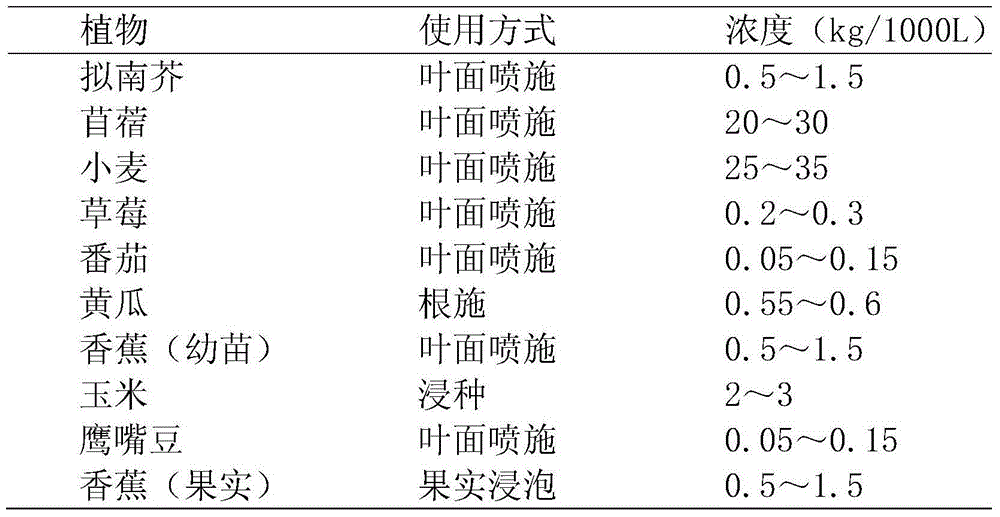Method for improving chilling resistance of plant via glycine betaine
A betaine and cold resistance technology, which is applied in the field of pesticides, can solve the problems that the safety of genetically modified products is not fully proved, and it is not suitable to be used in crop production, and achieves the effects of wide application range, improved resistance, and improved cold resistance.
- Summary
- Abstract
- Description
- Claims
- Application Information
AI Technical Summary
Problems solved by technology
Method used
Image
Examples
Embodiment 1
[0021] Embodiment 1: Seed soaking in betaine aqueous solution improves germination ability of corn seeds under low temperature stress
[0022] Treatment ①: Before accelerating germination, mix boiling water and cold water in half, take a certain amount of pure betaine to prepare an aqueous solution, and use 2 to 3 kg of betaine in 1000 liters, and put 60 selected corn seeds into the betaine aqueous solution During the process, the liquid level should exceed the seeds by 20-25 cm, and at the same time, stir with a wooden stick in time to make the seeds evenly heated. The water temperature should be controlled at 25-28 degrees Celsius. Soak the seeds for 3-5 hours under this temperature condition. After the seeds absorb water and swell, remove the seeds and divide them into two groups on average; treatment ② is the control: before germination, divide the boiled water and cold water in half Right, put the selected 60 corn seeds into warm water, the water surface should be 20-25 c...
Embodiment 2
[0026] Example 2: Foliar spraying of betaine under low temperature stress improves wheat viability
[0027] The betaine solution with a concentration of 30kg / 1000L is configured, and 40 wheat plants with the same growth and no damage by diseases and insect pests are selected and divided into two groups for treatment ①: foliar spraying of betaine, treatment ② control: foliar spraying of clear water, foliar spraying Spray the amount to cover the entire leaf surface until there are small drops of water dripping, air-dry and absorb naturally, after the surface of all wheat leaves has no moisture, put them in a ‐2°C constant temperature box for 12 hours of low temperature stress, and use an EGM-4 photosynthetic instrument to measure the total photosynthetic content. amount to calculate leaf mortality. The test results are shown in Table 3 below:
[0028] Table 3 Total photosynthetic amount and leaf mortality of wheat under low temperature stress
[0029]
[0030] The test resu...
Embodiment 3
[0031] Example 3: Applying betaine to cucumber seedlings under low temperature stress improves the ability of cucumber to resist low temperature
[0032] Select 40 healthy cucumber seedlings with the same growth, and divide them into two groups on average for treatment ①: use the prepared betaine solution with a concentration of 0.5kg / 1000L to root-apply cucumber seedlings for 24 hours, and ② treat with clean water as a control. The two groups of materials were subjected to low temperature stress at 6°C for 2 days, and then the content of malondialdehyde (MDA) and the activity of superoxide dismutase (SOD) were measured. The content of MDA was positively correlated with the degree of damage to the cell membrane. The lower the content of MDA, the more resistant the plant to cold. The better the resistance, the positive correlation between SOD activity and plant life activity, the higher the SOD activity, the better the cold resistance of plants. The test results are shown in Ta...
PUM
 Login to View More
Login to View More Abstract
Description
Claims
Application Information
 Login to View More
Login to View More - R&D
- Intellectual Property
- Life Sciences
- Materials
- Tech Scout
- Unparalleled Data Quality
- Higher Quality Content
- 60% Fewer Hallucinations
Browse by: Latest US Patents, China's latest patents, Technical Efficacy Thesaurus, Application Domain, Technology Topic, Popular Technical Reports.
© 2025 PatSnap. All rights reserved.Legal|Privacy policy|Modern Slavery Act Transparency Statement|Sitemap|About US| Contact US: help@patsnap.com



